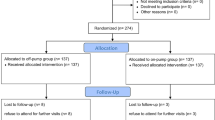Abstract
Purpose
Data regarding the effect of opium use on short-term outcome in patients undergoing coronary artery bypass surgery are limited. We sought to assess the morbidity and in-hospital mortality of current and past users compared the data with those from nonusers of opium after coronary artery bypass grafting (CABG).
Methods
This is a descriptive analytical review of prospectively collected data on 782 consecutive male patients who underwent isolated CABG between January 2005 and December 2007. Of these, 708 (90.5%) were nonusers, 56 (7.1%) were current users, and 18 (2.3%) were former opium users of more than 4 weeks. The effect of opium usage on clinical, admission, and outcome variables were analyzed.
Results
Current opium users were younger (P = 0.004) and more likely to be cigarette smokers (P = 0.0004). Other demographic characteristics, major coronary risk factors, rates of postoperative complications, intensive care unit readmission, postoperative length of stay, and in-hospital mortality did not differ among the three groups. Current opium users needed less analgesic postoperatively (P = 0.0001), were significantly less compliant with medical and dietary recommendations after discharge (P < 0.0001), and were more likely to be rehospitalized with cardiovascular causes within 6 months after CABG surgery; these differences were much more pronounced for nonusers versus current users of opium (P < 0.0001).
Conclusion
Continued use of opium is a significant predictor of rehospitalization with a cardiac cause within 6 months of CABG surgery. This may be partly due to the low compliance of these patients with treatment recommendations.
Similar content being viewed by others
References
Sadeghian S, Darvish S, Davoodi G, Salarifar M, Mahmoodian M, Fallah N, et al. The association of opium with coronary artery disease. Eur J Cardiovasc Prev Rehabil 2007;14: 715–717.
Ahmadi J, Toobaee S, Kharras M, Radmehr M. Psychiatric disorders in opioid dependants. Int J Soc Psychiatry 2003;49: 185–191.
Alemi AA. The iceberg of opium addiction. An epidemiological survey of opium addiction in a rural community. Drug Alcohol Depend 1978;3:107–112.
Ribeiro Pinto LF, Swann PF. Opium and oesophageal cancer: effect of morphine and opium on the metabolism of Nnitrosodimethylamine and Nnitrosodiethylamine in the rat. Carcinogenesis 1997;18:365–369.
Ghadirian P, Stein GF, Gorodetzky C, Roberfroid MB, Mahon GA, Bartsch H, et al. Oesophageal cancer studies in the Caspian littoral of Iran: some residual results, including opium use as a risk factor. Int J Cancer 1985;35:593–597.
Kalant H. Opium revisited: A brief review of its nature, composition, non-medical use and relative risks. Addiction 1997;92:267–277.
van den Brink OW, Delbridge LM, Rosenfeldt FL, Penny D, Esmore DS, Quick D, et al. Endogenous cardiac opioids: enkephalins in adaptation and protection of the heart. Heart Lung Circ 2003;12:178–187.
Gross ER, Hsu AK, Gross GJ. Opioid-Induced cardioprotection occurs via glycogen synthase kinase beta inhibition during reperfusion in intact rat hearts. Circ Res 2004;94:960–966.
American Psychiatric Association. Diagnostic and Statistical Manual of Mental Disorders, 4th ed., text revision. Washington, DC: American Psychiatric Association; 2000.
Gilman A, Goodman LS. The pharmacological basis of therapeutics. Seventh edition. New York: McGraw Hill; 2000.
United States Department of State. The 2003 International Narcotics Control Strategy Report (INCSR). 2004. http://www.state.gov/p/inl/rls/nrcrpt/2003.
Ahmadi J, Benrazavi L. Substance use among Iranian surgical patients. Int J of Drug Policy 2002;13:509–510.
Ludwig LM, Patel HH, Gross GJ, Kersten JR, Pagel PS, Warltier DC. Morphine enhances pharmacological preconditioning by isoflurane: role of mitochondrial K (ATP) channels and opioids receptors. Anesthesiology 2003;98:705–711.
Peart JN, Gross GJ. Adenosine and opioid receptor-mediated cardioprotection in the rat: evidence for cross-talk between receptors. Am J Physiol Heart Circ Physiol 2003;285:H81–H89.
Benedict PE, Benedict MB, Su TP, Bolling SF. Opiate drugs and deltareceptor-mediated myocardial protection. Circulation 1999;100:II357–II360.
Huh J, Gross GJ, Nagase H, Liang BT. Protection of cardiac myocytes via delta-1 opioid receptors, protein kinase C and mitochondrial K-ATP channels. Am J Physiol 2001;280: H377–H383.
Sanderson K, Nyberg F, Khalil Z. Modulation of peripheral inflammation by locally administered hemorphin-7. Inflamm Res 1998;47:49–55.
Czlonkowski A, Stein C, Herz A. Peripheral mechanisms of opioid antinociception in inflammation: involvement of cytokines. Eur J Pharmacol 1993;242:229–235.
Rady JJ, Portoghese PS, Fujimo JM. Methadone and heroin antinociception: predominant delta-opioid-receptor responses in methadone-tolerant mice. Jpn J Pharmacol 2002;88: 319–331.
North RA, Williams JT, Surprenant A, Christie MJ. Mu and delta receptors belong to a family of receptors that are coupled to potassium channels. Proc Natl Acad Sci U S A 1987; 84:5487–5491.
Ross R. The pathogenesis of atherosclerosis: a perspective for the 1990s. Nature 1993;362:801–809.
Libby P, Ridker PM, Maseri A. Inflammation and atherosclerosis. Circulation 2002;105:1135–1143.
Immer FF, Immer-Bansi AS, Trachsel N, Berdat PA, Eigenmann V, Curatolo M, et al. Pain treatment with a COX-2 inhibitor after coronary artery bypass operation: A randomized trial. Ann Thorac Surg 2003;75:490–495.
Jackson LM, Hawkey CJ. COX-2 selective nonsteroidal antiinflammatory drugs: Do they really offer any advantages? Drugs 2000;59:1207–16.
Abnet CC, Saadatian-Elahi M, Pourshams A, Boffetta P, Feizzadeh A, Brennan P, et al. Reliability and validity of opiate use self-report in a population at high risk for esophageal cancer in Golestan, Iran. Cancer Epidemiol Biomarkers Prev 2004;13:1068–70.
Author information
Authors and Affiliations
Corresponding author
Rights and permissions
About this article
Cite this article
Safaii, N., Kazemi, B. Effect of opium use on short-term outcome in patients undergoing coronary artery bypass surgery. Gen Thorac Cardiovasc Surg 58, 62–67 (2010). https://doi.org/10.1007/s11748-009-0529-7
Received:
Accepted:
Published:
Issue Date:
DOI: https://doi.org/10.1007/s11748-009-0529-7




